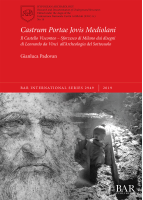Description
Il Castello di Milano è un’opera medievale voluta dai Visconti e potenziata dagli Sforza. Oggi è sede di biblioteche, musei e raccolte d’arte, ma rimane una formidabile “macchina da combattimento”, dove hanno lavorato tra i migliori architetti e ingegneri italiani. I soli studi d’epoca medievale riguardanti la Fortezza, a oggi noti, sono di Leonardo da Vinci, il quale ne ha esaminato le difese, comprensive delle parti sotterranee, prospettando i miglioramenti. Trent’anni d’indagini speleologiche condotte innanzitutto nei suoi sotterranei hanno permesso di eseguire le planimetrie dell’articolato sistema, composto anche di canali d’acqua segreti, mettendole a confronto con i disegni leonardeschi. Si è così compreso che una parte della Fortezza non è stata demolita, ma solo “cimata”: oggi nel sottosuolo esiste un patrimonio archeologico, architettonico e artistico inestimabile, ma da recuperare integralmente. Il lavoro presenta un metodo d’indagine multidisciplinare che può essere facilmente applicato allo studio di ogni altra fortificazione europea.
The castle of Milan is a medieval work commissioned by the Visconti and developed by the Sforza. Today it is intended for cultural functions but its origins are those of a formidable "combat machine". Some of the best Italian architects and engineers worked on the creation of the castle. The only studies known about the fortress, belonging to the medieval age, are by Leonardo da Vinci. He examined the defences, including the underground parts, looking for improvements. Thirty years of speleological investigations, first of all conducted in its basements, and also concerning secret water channels, have allowed us to carry out the plans of the complex system and to compare them with Leonardo's drawings. This has made it clear to the author that a part of the Fortress has not been demolished, but only "cut" in the surface. Today there is an invaluable archaeological, architectural and artistic heritage to be fully recovered. The work presents a method of multidisciplinary investigation that can be applied to the study of any other European fortification.
AUTHOR
Gianluca Padovan, veronese, speleologo, scrittore, fondatore e presidente della Associazione Speleologia Cavità Artificiali Milano (S.C.A.M.). Cofondatore della Federazione Nazionale Cavità Artificiali (F.N.C.A.) e condirettore della Collana “Hypogean Archaeology” della serie internazionale dei British Archaeological Reports di Oxford ha promosso la nuova disciplina per lo studio e la documentazione delle Cavità Artificiali a livello internazionale. Autore e coautore di numerosi libri sia a carattere scientifico sia divulgativo, stampati con case editrici italiane ed estere.
Gianluca Padovan, veronese, speleologist, writer, founder and president of the Associazione Speleologia Cavità Artificiali Milano (S.C.A.M.). Co-founder of the Federazione Nazionale Cavità Artificiali (F.N.C.A.) and co-director of “Hypogean Archaeology, international series of the British Archaeological Reports. He has promoted the new discipline for the documentation of Underground Structures internationally. Author and co-author of numerous books, both scientific and disclosure, printed with Italian and foreign publishers.
REVIEWS
‘The work is truly original. … Padovan's way of writing stimulates the desire to understand more what is still unexplored.’ Peer reviewer
‘Oltre che rivolgersi in modo esaustivo ad un pubblico di ricercatori ed esperti in ambito scientifico, il libro è assolutamente leggibile anche per un pubblico di non esperti che può scoprire, grazie alla scrittura scorrevole e alle bellissime immagini, un mondo sconosciuto, che è quello sotterraneo, e soddisfare molte curiosità.’ Peer reviewer











